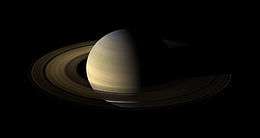Janus (moon)
|
Janus as imaged by Cassini on 2010-04-07: highest-resolution full-disk image to date | |
| Discovery | |
|---|---|
| Discovered by | Audouin Dollfus |
| Discovery date | 15 December 1966 |
| Designations | |
| Pronunciation | /ˈdʒeɪnəs/ JAY-nəs |
Named after | Janus |
| Adjectives | Janian |
| Orbital characteristics [1] | |
| Epoch December 31, 2003 (JD 2 453 005.5) | |
| 151460±10 km | |
| Eccentricity | 0.0068 |
| 0.694660342 d | |
| Inclination | 0.163°±0.004° to Saturn's equator |
| Satellite of | Saturn |
| Physical characteristics | |
| Dimensions | 203 × 185 × 152.6 km [2] |
Mean radius | 89.5±1.4 km [2] |
| Volume | ≈ 716000 km3 |
| Mass | (1.8975±0.0006)×1018 kg [2] |
Mean density | 0.63±0.03 g/cm³ [2] |
| 0.011–0.017 m/s2 [2] | |
| synchronous | |
| zero | |
| Albedo | 0.71±0.02 (geometric) [3] |
|
| |
Janus is an inner satellite of Saturn. It is also known as Saturn X. It is named after the mythological Janus.
History
Discovery
Janus was identified by Audouin Dollfus on 15 December 1966[4] and given the temporary designation S/1966 S 2. Previously, Jean Texereau had photographed Janus on 29 October 1966 without realising it. On December 18, Richard Walker observed an object in the same orbit as Janus, but whose position could not be reconciled with the previous observations. Twelve years later, in October 1978, Stephen M. Larson and John W. Fountain realised that the 1966 observations were best explained by two distinct objects (Janus and Epimetheus) sharing very similar orbits,[5] Rick Walker is now credited with the discovery of Epimetheus.[6] Voyager 1 confirmed this orbital configuration in 1980.[7] (See co-orbital moon for a more detailed description of their unique arrangement.)
Observational history
Janus was observed on subsequent occasions and given different provisional designations. Pioneer 11's three energetic-particle detectors detected its "shadow" when the probe flew by Saturn on 1 September 1979 (S/1979 S 2.[8]) Janus was observed by Dan Pascu on 19 February 1980 (S/1980 S 1,[9]) and then by John W. Fountain, Stephen M. Larson, Harold J. Reitsema and Bradford A. Smith on 23 February 1980 (S/1980 S 2.[10])
Name
Janus is named after the two-faced Roman god Janus. Although the name was informally proposed soon after the initial 1966 discovery,[11] it was not officially named until 1983,[lower-alpha 1] when Epimetheus was also named.
The Oxford English Dictionary lists the adjectival form of the moon's name as Janian.
Orbit
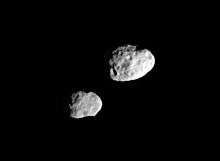

Janus's orbit is co-orbital with that of Epimetheus. Janus's mean orbital radius from Saturn is, as of 2006 (as shown by green color in the adjacent picture), only 50 km less than that of Epimetheus, a distance smaller than either moon's mean radius. In accordance with Kepler's laws of planetary motion, the closer orbit is completed more quickly. Because of the small difference it is completed in only about 30 seconds less. Each day, the inner moon is an additional 0.25° farther around Saturn than the outer moon. As the inner moon catches up to the outer moon, their mutual gravitational attraction increases the inner moon's momentum and decreases that of the outer moon. This added momentum means that the inner moon's distance from Saturn and orbital period are increased, and the outer moon's are decreased. The timing and magnitude of the momentum exchange is such that the moons effectively swap orbits, never approaching closer than about 10,000 km. At each encounter Janus's orbital radius changes by ~20 km and Epimetheus's by ~80 km: Janus's orbit is less affected because it is four times more massive than Epimetheus. The exchange takes place close to every four years; the last close approaches occurred in January 2006,[12] 2010 and 2014, and the next in 2018. This is the only such orbital configuration known in the Solar System.[13]
The orbital relationship between Janus and Epimetheus can be understood in terms of the circular restricted three-body problem, as a case in which the two moons (the third body being Saturn) are similar in size to each other.
Physical characteristics
Janus is extensively cratered with several craters larger than 30 km, but has few linear features. Janus's surface appears to be older than Prometheus's but younger than Pandora's.
Janus has a very low density and relatively high albedo, meaning that it is likely very icy and porous (a rubble pile).
Interactions with rings
A faint dust ring is present around the region occupied by the orbits of Janus and Epimetheus, as revealed by images taken in forward-scattered light by the Cassini spacecraft in 2006. The ring has a radial extent of about 5000 km.[14] Its source is particles blasted off their surfaces by meteoroid impacts, which then form a diffuse ring around their orbital paths.[15]
Along with Ephimetheus, Janus maintains the sharp edge of the A Ring by a 7:6 orbital resonance. The effect is more obvious when the more massive Janus is on the resonant (inner) orbit.[13]
Gallery
 Janus as viewed by Voyager 2 (1981-08-25).
Janus as viewed by Voyager 2 (1981-08-25)..jpg) Janus and Prometheus lie above and below Saturn's rings (2006-04-29).
Janus and Prometheus lie above and below Saturn's rings (2006-04-29).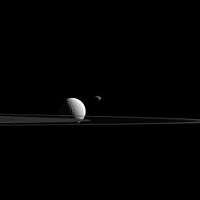 Janus and Tethys (foreground) near Saturn's rings (2015-10-27).
Janus and Tethys (foreground) near Saturn's rings (2015-10-27).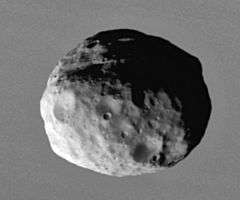 Janus in front of Saturn as imaged by Cassini (2006-09-25).
Janus in front of Saturn as imaged by Cassini (2006-09-25). Janus as imaged by Cassini (2008-02-20).
Janus as imaged by Cassini (2008-02-20).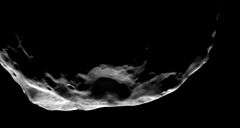 Crescent Janus (2008-06-30).
Crescent Janus (2008-06-30).
See also
Notes
- ↑ Transactions of the International Astronomical Union, Vol. XVIIIA, 1982 (confirms Janus, names Epimetheus, Telesto, Calypso) (mentioned in IAUC 3872: Satellites of Jupiter and Saturn, September 30, 1983)
References
- ↑ Spitale Jacobson et al. 2006.
- 1 2 3 4 5 Thomas 2010.
- ↑ Verbiscer French et al. 2007.
- ↑ IAUC 1987.
- ↑ Fountain & Larson 1978.
- ↑ IAUC 1991.
- ↑ Solar System, NASA: Janus.
- ↑ IAUC 3417.
- ↑ IAUC 3454.
- ↑ IAUC 3456.
- ↑ IAUC 1995.
- ↑ JPL/NASA: The Dancing Moons.
- 1 2 El Moutamid et al 2015.
- ↑ JPL/NASA: Moon-Made Rings.
- ↑ JPL/NASA: Creating New Rings.
Bibliography
- Fountain, J. W.; Larson, S. M. (1978). "Saturn's ring and nearby faint satellites". Icarus. 36: 92–106. Bibcode:1978Icar...36...92F. doi:10.1016/0019-1035(78)90076-3.
- El Moutamid, M.; et al. (1 October 2015). "How Janus' Orbital Swap Affects the Edge of Saturn's A Ring?". arXiv:1510.00434
 .
. - Gingerich, Owen (January 3, 1967). "Probable New Satellite of Saturn" (discovery). IAU Circular. 1987. Retrieved 2011-12-28.
- Gingerich, Owen (January 6, 1967). "Possible New Satellite of Saturn". IAU Circular. 1991. Retrieved 2011-12-28.
- Gingerich, Owen (February 1, 1967). "Saturn X (Janus)" (naming Janus). IAU Circular. 1995. Retrieved 2011-12-28.
- "PIA08170: The Dancing Moons". Photojournal. JPL/NASA. 2006-03-05. Retrieved 2016-01-17.
- "PIA08328: Moon-Made Rings". Photojournal. JPL/NASA. 2006-10-11. Retrieved 2011-12-29.
- "NASA Finds Saturn's Moons May Be Creating New Rings". Cassini Solstice Mission. JPL/NASA. October 11, 2006. Retrieved 2011-12-29.
- Marsden, Brian G. (October 25, 1979). "New Ring and Satellites of Saturn". IAU Circular. 3417. Retrieved 2011-12-29.
- Marsden, Brian G. (February 25, 1980). "Saturn". IAU Circular. 3454. Retrieved 2011-12-29.
- Marsden, Brian G. (February 29, 1980). "1980 S 2". IAU Circular. 3456. Retrieved 2011-12-29.
- Marsden, Brian G. (September 30, 1983). "Satellites of Jupiter and Saturn". IAU Circular. 3872. Retrieved 2011-12-23.
- "Saturn: Moons: Janus". Solar System Exploration: Planets. NASA. 4 Apr 2011. Retrieved 2011-12-29.
- Spitale, J. N.; Jacobson, R. A.; Porco, C. C.; Owen, W. M., Jr. (2006). "The orbits of Saturn's small satellites derived from combined historic and Cassini imaging observations" (PDF). The Astronomical Journal. 132 (2): 692–710. Bibcode:2006AJ....132..692S. doi:10.1086/505206.
- Thomas, P. C. (July 2010). "Sizes, shapes, and derived properties of the saturnian satellites after the Cassini nominal mission" (PDF). Icarus. 208 (1): 395–401. Bibcode:2010Icar..208..395T. doi:10.1016/j.icarus.2010.01.025.
- Verbiscer, A.; French, R.; Showalter, M.; Helfenstein, P. (9 February 2007). "Enceladus: Cosmic Graffiti Artist Caught in the Act". Science. 315 (5813): 815. Bibcode:2007Sci...315..815V. doi:10.1126/science.1134681. PMID 17289992. Retrieved 20 December 2011. (supporting online material, table S1)
External links
![]() Media related to Janus (moon) at Wikimedia Commons
Media related to Janus (moon) at Wikimedia Commons
- Janus Profile by NASA's Solar System Exploration
- The Planetary Society: Janus
- 'Solar System Dynamics' by Murray and Dermott The standard text on the subject, describes the orbits in detail.
- QuickTime illustration of co-orbital motion from Murray and Dermott
- Cassini image of Janus and Epimetheus near the time of their orbital swap.
- Janus nomenclature from the USGS planetary nomenclature page

